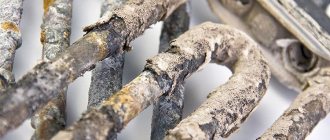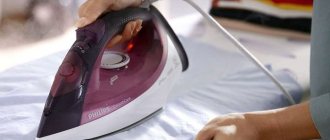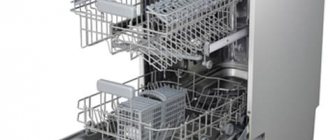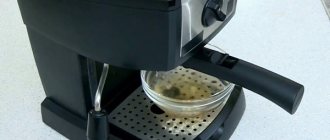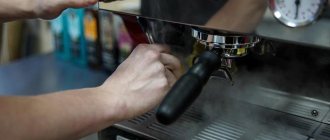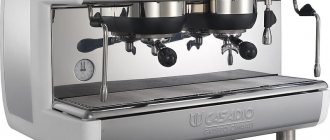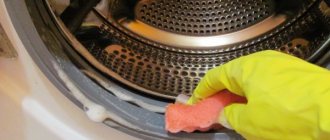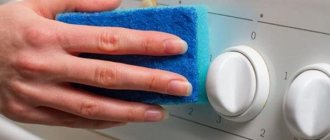Almost every person has encountered the problem of scale formation in an electric kettle and other electrical appliances, including a coffee machine. Over time, dense lime deposits begin to appear on the heating elements of the unit, which are difficult to remove with ordinary water. Cleaning the coffee machine with citric acid will allow you to get rid of scale as quickly and effectively as possible, without exposing the functional mechanisms of the unit to the harmful effects of aggressive chemicals and extend its service life without the need for repairs.
Why descale your coffee machine?
Pure water contains a large number of chemical elements such as calcium, magnesium, iron, potassium and chlorine, which when heated turn into lime, which settles on the heating elements of the machine. During the preparation of coffee, it flakes off and enters the drink in the form of white flakes, which make it unpresentable in appearance and tasteless. Scale also causes corrosion of various internal parts of the unit and leads to their premature failure. In addition, its porous structure promotes the proliferation of microorganisms and pathogenic bacteria.
Limescale, which accumulates inside the container and on the heating elements of the unit, forms a large layer of lime, which creates thermal resistance and worsens the thermal conductivity characteristics of the metal. This significantly increases the load on the electric heater and affects the length of time it takes to prepare the drink.
Most of the plaque is formed by calcium, so the procedure for cleaning a coffee machine is also called decalcification.
Signs indicating the need to clean the unit:
- the smell of coffee has changed (a musty feeling has appeared);
- the drink is not strong enough or is not fully brewed;
- steam pressure decreased significantly;
- During operation of the unit, uncharacteristic sounds are heard.
Some devices are equipped with special indicators for automatic control of scale. If a red light comes on on the device’s display or a corresponding message appears, it’s time to clean the coffee machine.
Why decalcify?
Over time, calcified elements form on the parts of the working coffee machine, which reduce the flow of water. The device stops heating water, increases energy consumption by 10-15%, and turns off for no reason. Pollution increases the volume of the unit, which causes discomfort to its owners.
If you use the device frequently, ferrous elements appear on its mechanisms. Because of them, drinks with low concentration are obtained, in which white flakes and a specific coating can be found. This kind of coffee is tasteless and clogs the body with toxins.
Decalcification of a coffee machine is necessary to improve the quality of drinks, save energy and prevent technical breakdowns.
Modern coffee machines have a special indicator that indicates that it is time to tidy up their insides. If there is no such function, clean the device at least 1-2 times every 2 months.
Is it permissible to clean a coffee machine with citric acid?
Today, many modern manufacturers offer a large number of different cleaning agents for coffee machines of different brands. But the best natural product for cleaning the unit is citric acid powder, which is sold in bags, as it has many benefits:
- it is safe for the human body;
- can effectively remove even old layers of scale;
- does not emit toxic substances during heating;
- environmentally friendly and does not harm the environment;
- cheaper than specialized products;
- can be purchased at any store.
Why this remedy?
Tribasic carboxylic acid is a water-soluble crystalline substance. As a result of the chemical interaction of this product with scale, a new compound is formed - sodium salt, which can be easily removed from the walls and components of the machine by regular washing.
Citric acid can effectively remove even old, stubborn lime deposits, is safe to use, does not emit toxic fumes and is absolutely harmless to human health and the environment.
Citric acid can also be used to clean a microwave, see this article for details.
REFERENCE! An important advantage of this product over chemicals sold in stores is its availability and low cost.
Cleaning the coffee machine with citric acid
To effectively descale the unit, you must fully read the manufacturer's instructions and follow its recommendations. When preparing a solution of citric acid, you must strictly observe the specified proportions and strictly follow the developed algorithm for the procedure.
Amount of citric acid
Many people think that descaling a coffee machine will be most effective if descaling is carried out with a large amount of citric acid. But too high a concentration of powder can lead to damage to the internal elements of the unit. Therefore, the solution is prepared in compliance with the following proportions:
- for regular cleaning of the coffee machine, dilute 25-30 g of citric acid in 1 liter of water;
- To decalcify a heavily contaminated unit, make the solution more concentrated by adding water and 45-50 g of lemon powder.
You can buy citric acid at any grocery store or supermarket.
Dilution of citric acid
To prepare the cleaning solution, you need to heat the required volume of water to room temperature, pour the specified amount of citric acid into it and mix thoroughly.
The amount of water is taken in accordance with the manufacturer’s recommendations, which are indicated in the operating instructions for the coffee machine.
Cleaning process
Typically, decalcification of a coffee machine lasts about 30-40 minutes and consists of the following steps:
- descaling;
- first rinse mode;
- second rinse mode.
The procedure for decalcification:
- First, you need to de-energize the unit (remove the plug from the electrical outlet).
- Remove the reservoir and rinse it several times with a strong stream of running water.
- Pour the prepared solution into it and install it back into the unit.
- Connect the coffee machine to the mains and select the automatic cleaning option. If this option is not available, leave the solution in the container for 20 minutes and then press the coffee button.
- Repeat the process until the entire volume of the solution is used up by the device.
- Then turn off the power to the unit, remove the tank and rinse it well under running water.
- Carefully inspect the walls of the container: if scale remains on them, repeat the procedure.
- Fill the tank with purified water to the maximum allowable level and turn on the coffee brewing function (no need to add beans).
- Repeat the rinsing process of the unit one more time.
If everything is done correctly, the coffee machine will be completely descaled, and you will be able to drink coffee made from clean and tasty water.
Alternative methods
available means will also help effectively deal with limescale stains in the unit . The algorithm for their use is similar to the use of citric acid.
Vinegar
To clean the walls of the tank and the heating elements of the device, you will need table vinegar: filling the unit with acetic acid or essence is unacceptable, as this can lead to damage to the device.
To prepare the product yourself, dilute the acidic liquid with warm water in a 1:2 ratio.
Cleaning procedure:
- disconnect the device from the power supply, remove and thoroughly rinse the liquid container;
- fill the reservoir with the prepared cleaning product;
- turn on the machine, wait for the water to boil, turn off the unit, remove the power plug from the socket;
- leave the device filled with liquid and vinegar for 8-10 hours;
- After the time has passed, drain the solution and rinse the container several times with clean water.
ATTENTION! After using vinegar, a pungent, specific odor often remains in the car. To eliminate the unpleasant aroma and sour taste, brew 2-3 cups of the drink and pour them out.
You can also clean the microwave using vinegar and soda, read more here.
Soda and salt
Another common way to remove plaque using home remedies is to use a soda-salt solution . This method is suitable for regular cleaning of household appliances and does an excellent job of removing a small layer of scale.
To remove lime deposits, follow these steps:
- dissolve soda and salt in warm water (at the rate of 1 teaspoon of sodium bicarbonate and sodium chloride per 1 liter of liquid), mix the components until all the crystals dissolve;
- pour the product into the tank of the machine and leave it to act on the scale (there is no need to turn on the device and heat the water);
- After 4 hours, pour the solution out of the container and rinse the coffee maker.
ATTENTION! To prevent the smallest particles of salt or soda remaining in the device from getting into the drink during the brewing process, after cleaning, turn on the unit, make 1-2 cups of coffee, which then pour it out.
Store-bought cleaning products
Home remedies undoubtedly have many advantages: low cost, ease of preparation of solutions and accessibility. But if they are used, there is a risk of making the drug too concentrated, which can harm the equipment.
The special products recommended by coffee machine manufacturers are absolutely safe for the machine , despite the relatively high cost.
Depending on the form of release, all industrial drugs can be divided into two groups:
- tableted;
- liquid.
As a rule, decalcinators very quickly and effectively remove even a thick layer of scale , as they are made on the basis of chemically active substances (acids).
If you have a Nespresso coffee machine, read the cleaning instructions here.
Liquid products are ready for use - just pour the amount of the drug specified in the instructions for the machine into the tank and perform cleaning:
- If the machine is not equipped with an automatic descaling program, fill the container with decalcifier and 1 liter of warm water. Turn on the unit, pour 2 cups of liquid through the hot water supply tube, turn off the machine, leaving the hot water control knob in the open position. After 5 minutes, start the drink preparation program. The first 2-3 cups of liquid are undrinkable and must be thrown away.
- If the unit has an automatic cleaning function, fill the reservoir with a special product, pour in 1 liter of water, close the hot liquid control knob and prepare 2 cups of drink along with the chemical, pour them out, turn on the automatic descaling cycle.
In terms of their composition, tablet products have minor differences from liquid ones; they also contain acid. Before starting the procedure, the tablet is dissolved in a certain amount of water (the proportions of the solution are indicated on the packaging of the cleaning product).
ATTENTION! After using chemicals, be sure to remove the liquid container from the device and rinse it several times with clean water.
Precautionary measures
Before cleaning the coffee machine, you must read the manufacturer's instructions, which indicate the frequency of the decalcification process. When cleaning the unit, all safety precautions should be observed:
- Before carrying out the procedure, you must disconnect the device from the power supply;
- For cleaning, use only products approved by the manufacturer;
- do not use concentrated solutions that may adversely affect the operation of internal elements;
- Avoid getting water on the internal parts of the coffee machine so that a short circuit does not occur after turning it on.
Automatic cleaning of the coffee machine
Many expensive coffee machines have an automatic limescale removal mode. Using this function is very convenient, because it can be programmed according to the instructions.
How to rinse - algorithm of actions when the coffee machine is clogged:
- The water reservoir must be cleared of any remaining coffee beans.
- Next comes the preparation of the cleaning solution, as indicated in the instructions.
- Turn on the automatic cleaning procedure.
- After this, you can rinse the brewing unit with clean water.
- Start the drink preparation program; it is better to drain the first glass of liquid.
If there is no automatic cleaning in household units, descaling is carried out manually using products recommended by the device manufacturer.
Pollution prevention
In order to reduce the amount of scale and reduce the number of procedures to remove it, experts recommend using only bottled or purified water with a low degree of hardness.
In addition, adjustments should be made to the water hardness setting system, since otherwise the device will signal too often (or very rarely) that the decalcification process is necessary.
Also, the use of purified water will be an effective prevention for units that are equipped with a built-in filtration system, since it is sometimes not enough to protect the important components of the coffee machine from the appearance of lime deposits.
Regardless of the configuration, technical characteristics and functionality of the coffee machine, it is recommended to decalcify it with citric acid or other special means at least once a year. This will not only help get rid of scale, but will also significantly extend the life of the household appliance.
How to descale
An easy way to remove limescale at home is to use citric acid, as it is a powerful limescale remover.
As a folk cleaning product, citric acid has the following properties:
- It does not pollute the environment;
- Does not form toxins;
- Limescale, when dissolved in citric acid, does not release harmful chemicals that are hazardous to health;
- A small amount of powdered citric acid dissolves even old scale.
- A package of citric acid is cheap and will save the family budget.
- There is no pungent odor.
- Citric acid does not spoil as long as it is stored in an airtight container, so the bags will last a very long time since you only need a small amount to process the coffee maker.
Process
Mix water and vinegar. Pour the solution into the fluid reservoir. Set the machine to cleaning mode or cooking mode. Repeat all steps, filling the reservoir with clean water.
Undoubtedly, cleaning a car with folk remedies is cheaper, but they also cost a lot. In addition, according to professionals, traditional methods do not work as well as a specially developed means for decalcifying a coffee machine. Therefore, if your car has not been cleaned for a long time, start caring for it immediately with a professional deposit cleaner.
Industrial products for cleaning coffee machines
Almost all serious manufacturers of modern coffee machines offer various special products for cleaning coffee machines. They are not cheap, but they guarantee high-quality results that extend the life of the device. The most famous among them are descaling liquids Saeco, DeLonghi, Melitta. Bosh offers a descaling agent for coffee machines in the form of tablets based on an active acid. You can clean your car using just one tablet.
Purchasing a branded cleaning product is justified if you use a high-end coffee machine, for example, Saeko, Delonghi or Bosch. The fine settings of these devices may be lost when using descaling products produced by unknown companies.
In all other cases, it is possible to use universal products, since their composition is approximately the same.
Preventive cleaning of the coffee machine can also be carried out after a certain number of coffees have been prepared.
Basic rules for caring for a coffee machine
Decalcification will be required much less frequently if you regularly and properly care for your kitchen appliance.
Rules of care:
- any means with which washing will be carried out must be suitable for the corresponding model of the machine - it can be either proprietary or universal;
- when deciding when to clean, be sure to take into account the hardness of the water - the harder it is, the more often rinsing will be required;
In order to properly clean the kitchen unit from various contaminants, you need to use only filtered water at room temperature.
Regular cleaning of limescale and coffee oil is a guarantee of its reliable and uninterrupted operation. When using various industrial or home remedies, be sure to read the instructions for the device. This will help avoid mistakes during cleaning and prevent damage to parts of the coffee machine.
